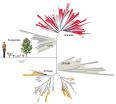Body's response to injury and inflammation may hinder wound healing in diabetes
'NETs' slow healing in diabetic mice, may contribute to delayed healing in people with diabetes
2015-06-15
(Press-News.org) One of the body's own tools for preventing wound infections may actually interfere with wound healing, according to new research from Boston Children's Hospital. In a study published online in Nature Medicine, scientists from the hospital's Program in Cellular and Molecular Medicine (PCMM) found they could speed up wound healing in diabetic mice by keeping immune cells called neutrophils from producing bacteria-trapping neutrophil extracellular traps (NETs).
The study, led by PCMM senior investigator Denisa Wagner, Ph.D., and postdoctoral fellow Siu Ling Wong, Ph.D., suggests that methods of preventing NET production or of cleaving NETs in a wound could, one day, possibly help alleviate wound healing problems in patients with diabetes.
Delayed wound healing is a common complication of both Type 1 and Type 2 diabetes. Open diabetic foot ulcers, for example, affect a quarter of people with diabetes and are a leading cause of amputations.
When the skin is cut or broken, the body mobilizes a complicated array of cells and proteins to stop bleeding, prevent infection by triggering inflammation and start the healing process. As part of the inflammatory response, neutrophils, which ingest and destroy bacteria, expel their own chromatin (a mix of DNA and associated proteins) in the form of NETs within the wound.
While possibly beneficial as a tool for keeping bacteria out of the body, NETs also have a dark side. 'NETs predispose patients to inflammation, heart disease and deep vein thrombosis [dangerous blood clots that form within veins deep inside the body], all of which are elevated in patients with diabetes,' says Wagner, who is also the Edwin Cohn Professor of Pediatrics at Harvard Medical School.
To see whether diabetes primes neutrophils to produce NETs, Wagner, Wong and colleagues at Joslin Diabetes Center and Pennsylvania State University examined neutrophils from patients with either Type 1 or Type 2 diabetes, finding that the cells contained four times the normal amount of PAD4 (a key enzyme in the NET production process) and made more NETs when stimulated. Further lab experiments revealed that neutrophils from healthy donors or mice when exposed to excessive glucose -- mimicking the diabetic environment -- were also more likely to release NETs than those incubated in normal glucose levels.
Diabetic mice in the study had more NETs in wounds and healed more slowly than normal mice. However, Wagner and Wong's team found that healing was accelerated in diabetic mice that lacked PAD4 (and therefore could not produce NETs).
To see whether cleaving NETs would have an effect similar to preventing their production, the research team treated mice with DNase 1 (an enzyme that breaks up DNA and therefore can destroy NETs). After three days, wounds on DNase 1-treated diabetic animals were 20 percent smaller than on untreated animals. Interestingly, DNase 1-treatment appeared to accelerate wound healing in healthy mice as well.
Wagner and Wong explain that NETs may impede wound healing in part because the dense, toxic mesh they produce interferes with new skin cells trying to enter the wound site. They also suggest that NETs may be redundant as a defense mechanism against bacteria.
'We don't fully understand the functions of NETs, but all of the other antimicrobial functions of neutrophils are preserved even if they cannot make NETs,' Wagner notes. 'Any injury that causes inflammation will result in production of NETs, and we think that if the injury involves skin repair, NETs will hinder the repair process.'
INFORMATION:
The study was supported by the American Diabetes Association (Innovation Award 7-13-IN-44); the National Heart, Lung and Blood Institute (grant number R01HL102101); the National Cancer Institute (grant number R01HL136856); the National Institute of Diabetes and Digestive and Kidney Diseases (grant number R01DK031036) and a GlaxoSmithKline/Immune Disease Institute Alliance Fellowship.
About Boston Children's Hospital
Boston Children's Hospital is home to the world's largest research enterprise based at a pediatric medical center, where its discoveries have benefited both children and adults since 1869. More than 1,100 scientists, including seven members of the National Academy of Sciences, 14 members of the Institute of Medicine and 14 members of the Howard Hughes Medical Institute comprise Boston Children's research community. Founded as a 20-bed hospital for children, Boston Children's today is a 395-bed comprehensive center for pediatric and adolescent health care. Boston Children's is also the primary pediatric teaching affiliate of Harvard Medical School.
For more information about research and clinical innovation at Boston Children's Hospital, visit: http://vector.childrenshospital.org.
To learn more about pediatric health, visit our Thriving blog: http://thriving.childrenshospital.org.
Join the social discussion and tweet us @BostonChildrens.
ELSE PRESS RELEASES FROM THIS DATE:
2015-06-15
University of California, Berkeley, scientists have identified more than 35 new groups of bacteria, clarifying a mysterious branch of the tree of life that has been hazy because these microbes can't be reared and studied in the lab.
The new groups make up more than 15 percent of all known groups or phyla of bacteria, the scientists say, and include the smallest life forms on Earth, microbes a mere 400 nanometers across. The number of new bacterial phyla is equal to all the known animal phyla on Earth.
The scientists, who recently also identified nine new groups of microbes ...
2015-06-15
Researchers estimate that 48.5 percent of the nearly 346,000 deaths from 12 cancers among adults 35 and older in 2011 were attributable to cigarette smoking, according to an article published online by JAMA Internal Medicine.
Researcher Rebecca L. Siegel, M.P.H., of the American Cancer Society, Atlanta, and coauthors provide an updated estimate because they note smoking patterns and the magnitude of the association between smoking and cancer death have changed in the past decade. While smoking prevalence decreased from 23.2 percent in 2000 to 18.1 percent in 2012, some ...
2015-06-15
New York, June 15 -- Led by Young Duck Kim, a postdoctoral research scientist in James Hone's group at Columbia Engineering, a team of scientists from Columbia, Seoul National University (SNU), and Korea Research Institute of Standards and Science (KRISS) reported today that they have demonstrated -- for the first time -- an on-chip visible light source using graphene, an atomically thin and perfectly crystalline form of carbon, as a filament. They attached small strips of graphene to metal electrodes, suspended the strips above the substrate, and passed a current through ...
2015-06-15
Diatoms in the world's oceans exhale more oxygen than all the world's rainforests. These tiny drifting algae generate about 20 percent of the oxygen produced on Earth each year and invisibly recycle gases enveloping our planet.
How diatoms will respond to the rising carbon dioxide levels is still unknown. A new study by the University of Washington and Seattle's Institute for Systems Biology, published June 15 in Nature Climate Change, finds the genetic ways that a common species of diatom adjusts to sudden and long-term increases in carbon dioxide.
'There are certain ...
2015-06-15
Does participation in the annual lung cancer screening currently recommended for people with high-risk smoking histories encourage those who are still smoking to quit? A new study from a Massachusetts General Hospital research team (MGH) finds that the answer may depend on the level of support given by patients' primary care providers. In the report receiving online publication in JAMA Internal Medicine, the team finds that, while providers' asking such patients about smoking did not increase their likelihood of quitting, providing more direct assistance - such as talking ...
2015-06-15
LOS ANGELES -- New research by an international team including Keck Medicine of USC scientists is bringing the origins of ovarian cancer into sharper focus.
The study, published online June 15 in the peer-reviewed journal Nature Genetics, highlights the discovery of three genetic variants associated with mucinous ovarian carcinomas (MOCs), offering the first evidence of genetic susceptibility in this type of ovarian cancer. The research also suggests a link between common pathways of development between MOCs and colorectal cancer and for the first time identifies a gene ...
2015-06-15
TORONTO, June 15 -- Researchers in Canada and the U.K. have for the first time sequenced and assembled de novo the full genome of a living organism, the bacteria Escherichia Coli, using Oxford Nanopore's MinIONTM device, a genome sequencer that can fit in the palm of your hand.
The findings, which were published today in the journal Nature Methods, provide proof of concept for the technology and the methods lay the groundwork for using it to sequence genomes in increasingly more complex organisms, eventually including humans, said Dr. Jared Simpson, principal investigator ...
2015-06-15
A new study, published in the British Journal of Sociology of Education, has found that while students' unions often try to oppose the rise of consumerism at their universities, they are rarely successful.
The team of researchers at the University of Surrey arranged various focus groups at 10 higher education institutions, with both students' union leaders and university managers. They found that the nature of relationships between unions and their university often makes it difficult for students' unions to reject consumerism - either because they have little independence ...
2015-06-15
Over the past nine years, Scot H. Simpson, professor in the faculty of Pharmacy and Pharmaceutical Sciences at the University of Alberta, has been studying the role of pharmacists on primary care teams and their impact on the health of patients with Type 2 diabetes.
His most recent study, Pharmacists on primary care teams: Effect on antihypertensive medication management in patients with Type 2 diabetes, published in the May/June issue of the Journal of the American Pharmacists Association, found that having pharmacists on primary care teams had a significant impact ...
2015-06-15
If you leave your job, chances are your pattern of cellphone use will also change. Without a commute or workspace, it stands to reason, most people will make a higher portion of their calls from home -- and they might make fewer calls, too.
Now a study co-authored by Massachusetts Institute of Technology researchers shows that mobile phone data can provide rapid insight into employment levels, precisely because people's communications patterns change when they are not working.
Indeed, using a plant closing in Europe as the basis for their study, the researchers found ...
LAST 30 PRESS RELEASES:
[Press-News.org] Body's response to injury and inflammation may hinder wound healing in diabetes
'NETs' slow healing in diabetic mice, may contribute to delayed healing in people with diabetes

